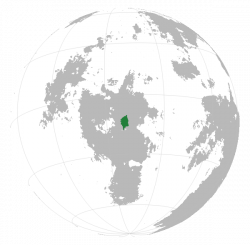Sangmia
| Confederation of Sangmia Chuiihenzheqigu hien Suunun (Haanzahlee) |
||||||
|---|---|---|---|---|---|---|
|
||||||
| Motto: "The sky shines above all" |
||||||
Location of Sangmia in Sahar
|
||||||
| Official languages | Haanzahlee Quite some others |
|||||
| Ethnic groups | Humans Kav Dalar |
|||||
| Demonym | Sangmian | |||||
| Government | Federal Directorial Republic | |||||
| - | Federal Councilman | |||||
| Indepedence from Letzia 1886 | ||||||
| Population | ||||||
| - | estimate | 19 million | ||||
| Time zone | CBT | |||||
| Calling code | +12 | |||||
| Internet TLD | .sg | |||||
Sangmia (IPA: /sɑŋmjə/, Haazahlee: Suunun, IPA: /sũːnũ/), officially the Confederation of Sangmia (Haazahlee: Chuiihenzheqigu hien Suunun IPA: /t͡ɕu̯iːɦẽd͡ʑeʈ͡ʂigu ɦi̯ẽ sũːnũ/), is a country located in Central Boroso, bordering Vaamek to the west and north and Tuanmali to the northeast. Sangmia is known for it's mountainous landscape and it's racial, religious and species-wise egalitarian policies, before Letzia domination the Sangmian territory was made of isolationist warring city-states, who managed to avoid various medieval empires by strictly controlling the mountains. During the Letzia colonial period Sangmia became more united, mostly due to the overarching anti-Letzia sentiment. It got independent from Letzia peacefully in 1886 right after the Independence of Khaazland.
Etymology
Most likely an exonym based on Proto-Sangmian *suŋṃ "mountain".
History
Ancient and Medieval Period
In ancient times the area was occupied by warring mountain tribes, eventually city states formed, prominently the Theocracy of Haanzash, ruled by the Dohmist High Monk. During the middle ages the region already had a certain cultural homogeneity and there seems to have been a strong mountain vs. not-mountain sentiment.
Letzic rule and Independence
The region was conquered by Letzia in the early seventeenth century, who assigned to the Theocracy the rule of the whole region. In the nearly three hundred years of Letzic rule there were numerous uprising but always isolated in one or two cities. Those increased in number in the after 1800 and specially after 1851 when Letzic rule was getting laxer. In 1867 High Monk Tieenuhiis rose to the Theocracy. He supported non-violence and initially favored Letzic rule. His oppinions shifted and in 1873 he started inciting non-violent civil disobedience movements, but his influence was not well seen outside of Haanzash for the other cantons still resented the Letzic attributed Haanzashian rule. To show his devotion to the Sangmian cause and widen his support in the other cantons, Tieenuhiis formally dismantled the Theocracy and reformed Dohmism in 1882, stating that the land was never his to rule. After that he was imprisoned by Letzia, who tried to reinstall a puppet leader, now from WIP, but ultimately failed to exert his rule in the other cantons. The civil disobedience continued and in 1885 a Sangmia-side mining strike managed to make Letzia free Monk Tieenuhiis. He returned to lead the independence movement and months after Khaazland independence in 1886 Letzia recognized the independence of Sangmia.
Due to the efforts of Monk Tieenuhiis Sangmia managed to come out of the independence process as a single country. Monk Tieenuhiis died in 1892 at age 84 after overextending a fast for religious acceptance for the Iovist, Devotionist and Kuyantist minorities.
The 1888 Sangmia Constituition stated Sangmia officially as the Confederation of Sangmia, the union of all it's cantons, and established a directorial republic ruled the Council of Seven, which would be the seven most voted in a nation-wide election.
Twentieth Century
The election system foreseen in the 1888 Constitution was flawed, and gave more power to Haanzash and WIP, as they were more populous and held a larger share of votes. Those districts were favored by the government for the next decades, leading to civil unrest in the other cantons.
The civil unrest is the less favored provinces grew steadily until there was an attempted Communist coup in 1943 that lead to a civil war which lasted only eight days. The central Sangmia government had military assistant from the VRCB and swiftly ended the uprising.
After the 1943 attempted coup the Sangmia government underwent a series of reforms and drifted away somewhat from it's previous far right leanings. The structure of the Federal Council itself was changed, going from the seven members chosen in a single nation-wide election to each canton having its representative councilmen, each being elected in canton level elections. That ceased to benefit Haanzash and WIP over the other cantons and gave more representation to the Kav and Dalar minorities. The 'Council of Seven' was officially changed to 'Federal Council' and had those changes implemented in the Constitution of 1946, the first elections under the new system were held in 1947.
The fifties, sixties and seventies saw a great deal of investment in the infrastructure of the outer cantons, with extensive road and rail construction. The eighties and nineties saw the embryo of a welfare state, with investment in public schooling and healthcare.
Vaamek-Dhwer conflict
In the onset of the Vaamek-Dhwer conflict the Federal Council issued a nation-wide poll on whether to join the war or not, the result was that 78,5% of voters were against Sangmia intervening. Towards the end of the war the Sangmian provided humanitarian aid to the newly formed state of Vaamek and to the war torn Vaamek-Dhwer frontier.


